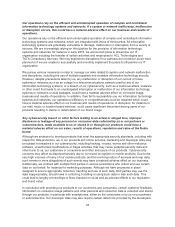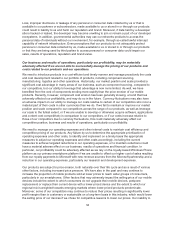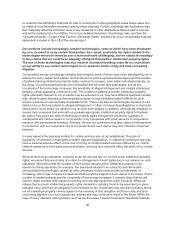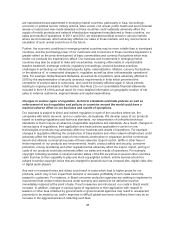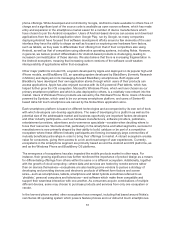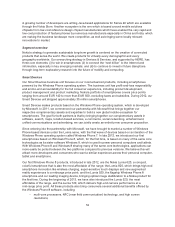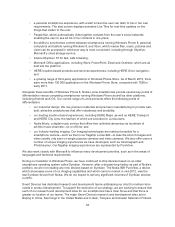Nokia 2012 Annual Report Download - page 44
Download and view the complete annual report
Please find page 44 of the 2012 Nokia annual report below. You can navigate through the pages in the report by either clicking on the pages listed below, or by using the keyword search tool below to find specific information within the annual report.Beginning on April 3, 2013, certain restrictions on the transfer of Nokia’s and Siemens’ interests in
Nokia Siemens Networks expire and certain other provisions relating to the transfer of such interests
come into effect. Otherwise, the arrangements between Nokia and Siemens as shareholders of Nokia
Siemens Networks will remain in effect as originally agreed. There can be no assurances, however,
that the ownership of Nokia Siemens Networks will, or will not, change in the future. We cannot
exclude the possibility that the expiration of these restrictions, or any plans for changes or actual
changes that alter the ownership structure of Nokia Siemens Networks, would not have an adverse
effect on Nokia Siemens Networks or us.
Nokia Siemens Networks may fail to effectively and profitably invest in new competitive
products, services, upgrades and technologies and bring them to market in a timely manner.
The mobile broadband infrastructure and related services market is characterized by rapidly changing
technologies, frequent new solutions requirements and product feature introductions and evolving
industry standards.
Nokia Siemens Networks’ success depends to a significant extent on the timely and successful
introduction of new products, services and upgrades of current products to comply with emerging
industry standards and to address competing technological and product developments carried out by
its competitors. The research and development of new and innovative technologically-advanced
products, including the introduction of new radio frequency technologies, as well as upgrades to
current products and new generations of technologies, is a complex and uncertain process requiring
high levels of innovation and investment, as well as accurate anticipation of technology and market
trends. Nokia Siemens Networks may focus its resources on technologies that do not become widely
accepted or ultimately prove not to be viable. Nokia Siemens Networks’ net sales and operating results
will depend to a significant extent on its ability in below areas:
• to maintain a product portfolio and service capability that is attractive to its customers;
• to enhance its existing products;
• to continue to introduce new products successfully and on a timely basis; and
• to develop new or enhance existing tools for its services offerings.
Nokia Siemens Networks’ failure to effectively and profitably invest in new products, services,
upgrades and technologies and bring them to market in a timely manner could result in a loss of net
sales and market share and could have a material adverse effect on our results of operations,
particularly profitability, and financial condition.
Nokia Siemens Networks also depends on its customers’ perception of its technological strengths and
weaknesses. For instance, its perceived lack of end-to-end capabilities in areas such as intellectual
property transformation and of innovation capabilities and integration into the innovation ecosystem
may be seen as weaknesses. Nokia Siemens Networks’ relatively small presence in the centers of
innovation ecosystems in telecommunications may harm its perceived credibility in terms of innovation
capability.
Nokia Siemens Networks business is dependent on a limited number of customers.
The networks infrastructure and related services business is dependent on a limited number of
customers and consolidation among those customers is continuing. A large number of net sales that
Nokia Siemens Networks generates have historically come from a limited number of customers. As
consolidation among existing customers continues, it is possible that an even greater portion of Nokia
Siemens Networks’ net sales will be attributable to a smaller number of large service providers. In
addition, mobile operators are increasingly entering into network sharing arrangements, as well as joint
procurement agreements, which further reduce the number of networks available for it to service. As a
43


